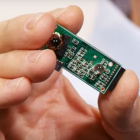nlshrake
Member Since: June 15, 2010
Country: United States
-
so many companies and individuals rushing into this sphere. the concept of paying virtual currency for a slider button just makes my skin itch. very nice hardware though.
-
I posted a RN42-HID python console that can be used with the FT232 break-out boards for easy prototyping and configuration. The console allows you to enter/exit command mode, set HID configuration mode, and send raw HID packets. I would not recommend this product for new development though as Microchip provides no support whatsoever and HID-gamepad functionality is crippled. Look into the Bluegiga WT-12 module for this application.
You can find the link here: https://github.com/shraken/rn42-hid-console
-
Super Expensive. Check out the GreyBeard peristaltic pump. http://www.amazon.com/Grey-Beards-Niagara-Rotary-Pump/dp/B00AN72VOI/ref=sr_1_6?ie=UTF8&qid=1400879607&sr=8-6&keywords=peristaltic+pump
-
There is an option specified in the datasheet on pg. 32. You can issue a 'set wlan join 2' command and also issue a 'set wlan auth 0' command. The former sets the module to connect to the network with best RSSI for the given auth type. The later sets the auth type to OPEN networks with no security.
I tested this on firmware 2.32 but I swear when I upgraded to 4.41 GSX it broke. I have a similar application but I manually scan and issue commands for a join.
-
Some open questions about this project, namely:
How does the unit perform in bright sunlight conditions? What about in the presence of external light sources such as street lamps? Yes they are transmitting coded messages and doing synchronous detection but one still has to be concerned about saturating the amplifier from external CW sources.
The data sheet quotes a maximum range distance of 5 meters without optics and 40 meters with. What is the average optical power incident on the photodiode for reflection off a white surface. This matters because there doesn't appear to be any gain control. If the gain is fixed so that small distances don't saturate the amplifier then the signal to noise ratio at this distance will be very poor.
How does this compare to a conventional ultrasonic based sensor such as the line of Maxbotix sensors sold at sparkfun. The LIDAR-lite data sheet quotes an absolute accuracy of 5% presumably across the entire 0 to 5 meter range. No absolute accuracy is provided from Maxbotix but if you look at this link: http://www.maxbotix.com/articles/057.htm
The worst case for a 500mm test was 494mm with a given sensor so a worst case accuracy of 1.2%. Maxbotix quotes a standard deviation of 2.3mm and 2.6mm for distances of 500mm and 1m respectively. LIDAR-lite doesn't provide this specification which is a bummer as this is the real defining performance specification.
-
I like this chip a lot but the stock firmware is absolute crap (version 2.X build year 2012) . There should be a disclaimer to immediately do an upgrade on the firmware because Roving Networks or Microchip has made substantial improvements in the latest revision (version 4.41 1/17/2014).
The stock firmware had a hard limit on the number of bytes transmitted during an HTTP Client GET/POST request which was causing my parameter string to abruptly get cut off before sending. Really random error, tracked it down in the HTTP access logs and firmware upgrade fixed it.
I also had an issue with the 'sleep' command bricking the module into an unrecoverable Web interface. Contacted Microchip support and was informed that this is internally documented issue. Upgrading to new firmware seems to have fixed any problem.
In summary, upgrade the firmware the second you solder it down.
-
I think they are not being manufactured anymore. They claim to have a limited supply but useless for volume projects.
http://www.richardsonrfpd.com/content/english/aboutus/Pages/Suppliers-Storefront.aspx?supplierId=1054
"Sarantel, Ltd has ceased operations. Their patented ceramic loaded helix antennas are not longer being manufactured. Richardson RFPD has a limited amount of inventory available. All product is for sale but the factory warranty implied in Sarantel data sheets is void. Please contact Richardson RFPD for additional information or alternative sources."
I really like these antennas and they always worked well inside for me. Is there a comparable antenna on the market?
-
This module works, I verified operation for both A (115200 baud) and B (4800 baud). I tested on windows with putty and mac osx with coolterm.
-
Toni, thanks for the response. A nice quick fix I used was to buy a nano/micro SIM adapter from ebay. These can be had for around $2.
-
Does this revision fix the RF impedance issued mentioned by John Beans in the previous product page: https://www.sparkfun.com/products/11067
Both layouts appear to be 50 mil. The trace length is around 140 mil for both. This gives an impedance of roughly 75 ohms. The RF Input on the Copernicus is a 50 ohm input however. The trace width needs to be wider for 0.064" thickness with 1 oz copper thickness. Am I missing something here?
I've attached screenshot of existing setup: http://imgur.com/yEvXdVo
I've attached screenshot of what I think is a properly sized transmission line: http://imgur.com/msl875R
GPS L1 power on the reciever is very low, like attowatts. The signal is literally below the noise floor so decibels really matter here, so losing 50% of the power is a big deal.
No public wish lists :(







